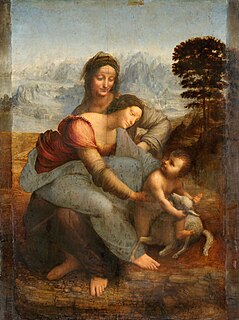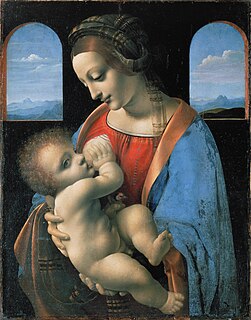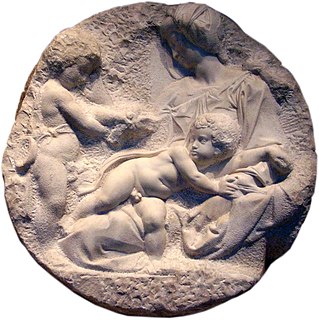| The Virgin and Child with St Anne and St John the Baptist | |
|---|---|
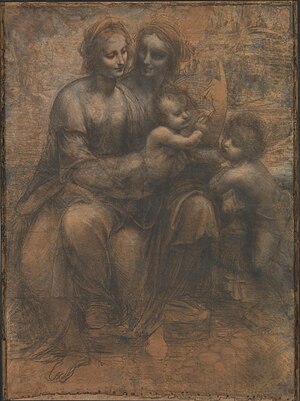 | |
| Artist | Leonardo da Vinci |
| Year | c. 1499–1500 or c. 1506–8 |
| Medium | charcoal, black and white chalk on tinted paper mounted on canvas |
| Dimensions | 141.5 cm× 104.6 cm(55.7 in× 41.2 in) |
| Location | National Gallery, London |
The Virgin and Child with St Anne and St John the Baptist, sometimes called The Burlington House Cartoon, is a drawing by Leonardo da Vinci. The drawing is in charcoal and black and white chalk, on eight sheets of paper glued together. Because of its large size and format the drawing is presumed to be a cartoon for a painting. No painting by Leonardo exists that is based directly on this cartoon.
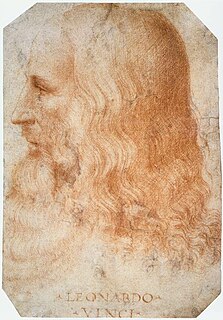
Leonardo di ser Piero da Vinci, more commonly Leonardo da Vinci or simply Leonardo, was an Italian polymath of the Renaissance whose areas of interest included invention, drawing, painting, sculpting, architecture, science, music, mathematics, engineering, literature, anatomy, geology, astronomy, botany, writing, history, and cartography. He has been variously called the father of palaeontology, ichnology, and architecture, and he is widely considered one of the greatest painters of all time. Sometimes credited with the inventions of the parachute, helicopter, and tank, he epitomised the Renaissance humanist ideal.
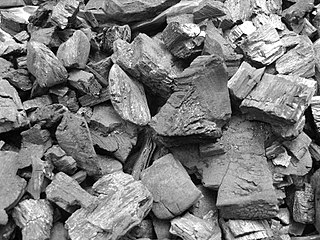
Charcoal is the lightweight black carbon and ash residue hydrocarbon produced by removing water and other volatile constituents from animal and vegetation substances. Charcoal is usually produced by slow pyrolysis — the heating of wood or other substances in the absence of oxygen. This process is called charcoal burning. The finished charcoal consists largely of carbon.

Chalk is a soft, white, porous, sedimentary carbonate rock, a form of limestone composed of the mineral calcite. Calcite is an ionic salt called calcium carbonate or CaCO3. It forms under reasonably deep marine conditions from the gradual accumulation of minute calcite shells (coccoliths) shed from micro-organisms called coccolithophores. Flint (a type of chert) is very common as bands parallel to the bedding or as nodules embedded in chalk. It is probably derived from sponge spicules or other siliceous organisms as water is expelled upwards during compaction. Flint is often deposited around larger fossils such as Echinoidea which may be silicified (i.e. replaced molecule by molecule by flint).
Contents
The drawing depicts the Virgin Mary seated on the knees of her mother, St Anne, while holding the Child Jesus as Jesus' young cousin, St. John the Baptist, stands to the right. It currently hangs in the National Gallery in London.

According to apocryphal Christian and Islamic tradition, Saint Anne, of David's house and line, was the mother of Mary and grandmother of Jesus. Mary's mother is not named in the canonical gospels, but is mentioned as the daughter of Faqud in Quran. In writing, Anne's name and that of her husband Joachim come only from New Testament apocrypha, of which the Gospel of James seems to be the earliest that mentions them.

John the Baptist was a Jewish itinerant preacher in the early first century AD. John is revered as a major religious figure in Christianity, Islam, the Bahá'í Faith, and Mandaeism. He is called a prophet by all of these faiths, and is honored as a saint in many Christian traditions. Other titles for John include John the Forerunner in Eastern Christianity and "the prophet John (Yaḥyā)" in Islam. To clarify the meaning of "Baptist", he is sometimes alternatively called John the Baptizer.

London is the capital and largest city of both England and the United Kingdom. Standing on the River Thames in the south-east of England, at the head of its 50-mile (80 km) estuary leading to the North Sea, London has been a major settlement for two millennia. Londinium was founded by the Romans. The City of London, London's ancient core − an area of just 1.12 square miles (2.9 km2) and colloquially known as the Square Mile − retains boundaries that follow closely its medieval limits. The City of Westminster is also an Inner London borough holding city status. Greater London is governed by the Mayor of London and the London Assembly.
It was either executed in around 1499–1500, at the end of the artist's first Milanese period, or around 1506–1508, when he was shuttling between Florence and Milan. The majority of scholars prefer the latter date, although the National Gallery and others prefer the former. [1]







